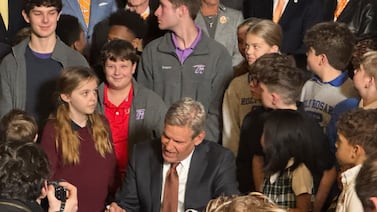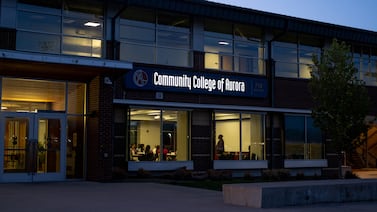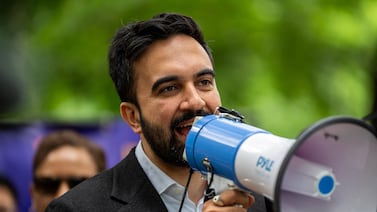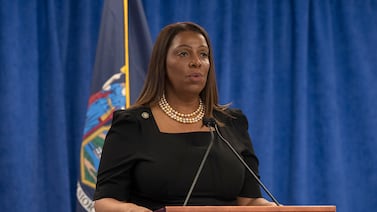Online classes have meant a learning curve for all children, but they pose a particular challenge for Jonathan Hooper’s students, who are blind or visually impaired. Many of them rely on tactile learning materials for which there are no digital substitutes.
Because with the right accommodations blind students can learn and thrive alongside their seeing classmates, Hooper has spent the past year making sure his students have what they need to do their work remotely. “One of my primary roles is to be the bridge between inaccessible content and accessible content,” said Hooper, who works with students across age groups at multiple New York City public schools. “Basically, my day looks like: creating accessible materials, seeing students remotely, creating accessible materials, communicating with parents, communicating with teachers, making sure things are accessible. You get the idea.”
The Braille Institute recently named Hooper its Teacher of the Year for his work with visually impaired children over the past eight years in New York, and especially during distance learning. Hooper also coordinates the NYC Braille Challenge, an academic competition for visually impaired students, and teaches Braille at Hunter College. He spoke recently with Chalkbeat about what drew him to the field, and the challenges and rewards of what he calls “the grooviest job ever.”
This interview has been lightly edited for length and clarity.
How did you come to be a teacher of blind and visually impaired students?
I started teaching as a general education reading teacher in Tennessee. One of my students had a visual impairment. He was a struggling reader who had poor attendance and disliked school. I had no experience with students with visual impairment, so I looked up ways to help him. After making adjustments to the material I gave him, he started coming to school more. By the end of the year, he was at grade level in reading. This showed me how small accommodations can greatly impact the educational experience of a student with a visual impairment. The next year, I moved 100 miles to go back to school to learn how to work with students with visual impairments.
What challenges do you face teaching visually impaired students during the pandemic?
Whoa! The very nature of distance learning has created a variety of barriers for students with sensory impairments. This year my students are mostly under the age of 9, and many of them are Braille users. This means their primary way to access learning and literacy is tactile. Before distance learning, my students used a variety of tools, like tactile graphics and paper Braille. Transitioning from a physical model of materials to a 100% digital model was a steep learning curve for many of my students.
Additionally, some materials have to be physical. For instance, one of my students learned about how to read a map this year. The students learned about the concept of North, South, East, West, and how to find parts of a map. This could not be done digitally, so I created tactile maps and mailed them to the student. This requires a partnership with the classroom teachers and lots of advanced planning. And to be honest, classroom teachers are stretched very thin this year.
Tell us about the NYC Braille Challenge and your role in it.
The NYC Braille Challenge is my favorite day of the entire year! I am the coordinator, but the NYC Braille Challenge is organized by a team of my colleagues who are equally as dedicated to our event and Braille literacy as a whole.
The Braille Challenge is a national program of the Braille Institute. Each year, regional events happen around the U.S. and Canada to identify national finalists. The Braille Challenge is the only national Braille literacy competition of its kind in the country, and it is specifically designed to challenge and reward students who are blind for their study of Braille. The categories of the competition include reading comprehension, writing speed and accuracy, proofreading, spelling, and interpreting tactile charts and graphs.
Our event is special in that it includes far more than the academic challenge. We bring in more than 20 community agencies that serve students with visual impairments to meet with parents. We have parent learning sessions focused on a variety of topics from blindfold experience to panels of blind adults. We facilitate unique tactile learning experiences for our students. Last year, we coordinated with the MTA to bring a city bus so students could touch all the parts of a bus. This is meaningful because the knowledge and understanding of a bus they learned by touching the bus is wildly different from getting on a bus in service on any given day.
Most importantly, our competitors have fun! We partner with Camp Abilities each year to bring movement and a love of sports to our event. This also empowers them to advocate for access to recreation and leisure when they are back in their community schools.
Oh, and I would be remiss if I didn’t say that last year we sent two students to nationals who placed. Woo-hoo.
What do you want people to know about your students?
First, my students are the coolest.
Second, do not underestimate students with visual impairments. Given accommodations, students with visual impairments can succeed alongside their typically sighted peers. Maybe it’s a ball with a bell in it for PE. Maybe it’s a large print worksheet for math. Maybe it’s a tactile map for social studies. The important thing is that students with visual impairments have access to the same activities that their sighted classmates have access to.
Third, we need dedicated educators to join our community. There is a shortage of teachers of students with visual impairment nationwide. Join us in having the grooviest job ever.
What’s the best advice you’ve ever received, and how have you put it into practice?
Like Ms. Frizzle from the Magic School Bus says, “Take chances, make mistakes, get messy.”
I put that into practice by giving my students the space to take chances. To be comfortable making mistakes and using those moments to grow. And to explore the world tactilely, even if that sometimes gets your fingers messy.







